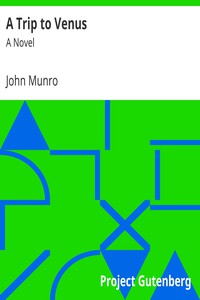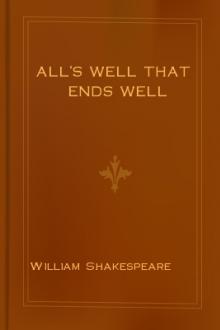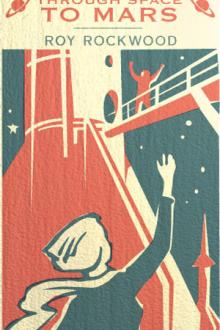A Trip to Venus: A Novel by John Munro (best books for 7th graders .TXT) 📖

- Author: John Munro
Book online «A Trip to Venus: A Novel by John Munro (best books for 7th graders .TXT) 📖». Author John Munro
"The red planet beyond the earth is Mars, who appears in the sky as a ruddy gold or coppery star. He is 141 million miles from the sun, travels his orbit in 687 days, and wheels round his axis in 24 hours 37 minutes. His diameter is 4,200 miles, and his mass about one-ninth that of the earth. A body weighing two pounds on the earth would only make half a pound on Mars. As you know, his atmosphere is clear and thin, his surface flat, and subject to floods from the melting of the polar snows. Mars is evidently a colder and more aged planet than the earth.
"He is accompanied by two little moons, Phobos (Fear), which is from ten to forty miles in diameter, and revolves round him in 7 hours 39 minutes, at a distance of 6,000 miles, a fact unparalleled in astronomy; and Deimos (Rout), who completes a revolution in 30 hours 18 minutes, at a distance of 14,500 miles.
"About 400 planetoids have been discovered up to now, but we are always catching more of them. Medusa, the nearest, is 198 million miles, and Thule, the farthest, is 396 million miles from the sun. Vesta, the brightest and probably the largest, a pale yellow, or, as some say, bluish white orb, visible with the naked eye, is from 200 to 400 miles in diameter. It is impossible to say which is the smallest. Probably the mass of the whole is not greater than one quarter that of the earth.
"Jupiter, surnamed the 'giant planet,' who almost rivals Venus in her splendour, is 480 million miles from the sun; travels round his orbit in 12 years less 50 days; and is believed to whirl round his axis in 10 hours. His diameter is 85,000 miles, and his bulk is not only 1,200 times that of the earth, but exceeds that of all the other planets put together. Nevertheless, his mass is only 200 to 300 times that of the earth, for his density is not much greater than that of water. What we see is evidently his vaporous atmosphere, which is marked by coloured spots and bands or belts, probably caused by storms and currents, especially in the equatorial regions. Jupiter is thought to be self luminous, at least in parts, and is, perchance, a cooling star, not yet entirely crusted over.
"Four or five numbered satellites, about the size of our moon and upwards, are circulating round him in orbits from 2,000 to 1,000,000 miles distant in periods ranging from 11 hours to 16 days 18 hours.
"Saturn, the 'ringed planet,' who appears as a dull red star of the first magnitude, is the most interesting of all the planets. He is 884 million miles from the sun; his period of revolution is 29½ years, and he turns on his axis in 10 hours 14 minutes. His diameter is 75,000 miles, but his mass is only 94 times that of the earth, for he is lighter than pinewood. His atmosphere is marked with spots and belts, and on the whole his condition is like that of Jupiter.
"Two flat rings or hoops, divided by a dark space, encircle his ball in the plane of his equator. The inner ring is over 18,000 miles from the ball, and nearly 17,000 miles broad. The gap between is 1,750 miles wide, and the outer ring is over 10,000 miles broad. The rings are banded, bright or dark, and vary in thickness from 40 to 250 miles. They consist of innumerable small satellites and meteoric stones, travelling round the ball in rather more than ten hours, and are brightest in their densest parts. Of course they form a magnificent object in the night sky of the planet, and it may be that our own zodiacal light is the last vestige of a similar ring, and not an extension of the solar corona.
"Saturn has eight moons outside his rings, the nearest, Mimas, being 115,000, and the farthest, Japetus, 220,400 miles from his ball. With the exception of Japetus, they revolve round him in the plane of his rings, and when these are seen edgewise, appear to run along it like beads on a string.
"Uranus, the next planet visible, is a pale star of the sixth magnitude, 1,770 million miles from the sun, and completes his round in 84 years. His axis, differing from those of the foregoing planets, lies almost in the plane of his orbit, but we cannot speak as to his axial rotation. He is 31,000 miles in diameter, and somewhat heavier, bulk for bulk, than water. Four satellites revolve round him, the nearest, Ariel, being 103,500, and the farthest, Oberon, 347,500 miles distant. Unlike the orbits of the foregoing satellites, which are nearly in the same plane as the orbits of their primaries, those of the satellites of Uranus are almost perpendicular to his own. They are travelled in periods of two and a half to thirteen and a half days.
"Neptune, invisible to the naked eye, but seen as a pale blue star in the telescope, is 2,780 million miles from the sun, and makes a revolution in 165 years. His diameter is about 35,000 miles, and his density rather less than that of water.
"Neptune has one satellite, at a distance of 202,000 miles, which, like those of Uranus, revolves about its primary in an orbit at a considerable angle to his own in five days twenty-one hours. Both Neptune and Uranus are probably dying suns.
"Comets of unknown number travel in long elliptical or parabolic orbits round the sun at great velocities. They seem to consist partly of glowing vapours, especially hydrogen, and partly of meteoric stones. 'Shooting stars,' that is to say, stones which fall to the earth, are known to swarm in their wake, and are believed to be as plentiful in space as fishes in the sea."
"The trash or leavings of creation," said I reflectively.
"And the raw material, for nothing is lost," rejoined Gazen. "Now, in spite of all its diversity, there is a remarkable symmetry in the solar system. The planets are all moving round the sun in one direction along circular paths. As a rule each is nearly as far again from the sun as the next within it. Thus, if we take Mercury as ¾ inch from the sun, Venus is about 1¼ inches, the Earth 2¼, Mars 2, the planetoids 5¼, Jupiter 9¾, Saturn 14, Uranus 36, and Neptune 60 inches. On the same scale, by the way, Enckes' comet at Aphelion, its farthest distance from the sun, would be about 12 feet; Donatis almost a mile; and Alpha Centauri, a near star in the Milky Way, some ten miles.
"The stately march of the planets in their orbits becomes slower the farther they are from the sun. The velocity of Mercury in its orbit is thirty, that of Jupiter is eight, and that of Neptune is only three miles a second. On the other hand, the inner planets, as a rule, take some twenty-four hours, and the outer only ten hours to spin round their axis. The inner planets are small in comparison with the outer. If we represent the sun by a gourd, 20 inches in diameter, Mercury will seem a bilberry (⅟₁₆ inch) Venus, a white currant, the Earth a black currant (¼ inch), Mars a red currant (⅛ inch), the planetoids as fine seed, Jupiter an orange or peach (2 inches), Saturn a nectarine or greengage (1 inch), Uranus a red cherry (¾ inch), and Neptune a white cherry (barely 1 inch in diameter). By putting the sun and planets in a row, and drawing a contour of the whole, we obtain the figure of a dirk, a bodkin, or an Indian club, in which the sun stands for the knob (disproportionately big), the inner planets for the handle, and the outer for the blade or body. Again, the average density of the inner planets exceeds that of the outer by nearly five to one, but the mass of any planet is greater than the combined masses of all which are smaller than it. The inner planets derive all their light and heat from the sun, and have few or no satellites; whereas the outer, to all appearance, are secondary suns, and have their own retinue of worlds. On the similitude of a clan or house we may regard the inner planets as the immediate retainers of the chief, and the outer as the chieftains of their own septs or families."
"How do you account for the symmetrical arrangement?" I enquired.
"The origin of the solar system is, you know, a mystery," replied the astronomer. "According to the nebular hypothesis we may imagine that two or more dark suns, perhaps encircled with planets, have come into collision. Burst into atoms by the stupendous shock they would fill the surrounding region with a vast nebula of incandescent gases in a state of violent agitation. Its luminous fringes would fly immeasurably beyond the present orbit of Neptune, and then rush inwards to the centre, only to be driven outwards again. Surging out and in, the fluid mass would expand and contract alternately, until in course of ages the fiery tides would cease to ebb and flow. If the impact had been somewhat indirect it would rotate slowly on its axis, and under the influence of gravity and centrifugal force acquire a globular shape which would gradually flatten to a lenticular disc. As it cooled and shrank in volume it would whirl the faster round its axis, and grow the denser towards its heart. By and by, as the centrifugal force overcame gravity, the nebula would part, and the lighter outskirts would be shed one after another in concentric rings to mould the planets. The inner rings, being relatively small and heavy, would probably condense much sooner than the large, light, outer rings. The planetoids are apparently the rubbish of a ring which has failed to condense into one body, perhaps through its uniformity or thinness. The separation of so big a mass as Jupiter might well attenuate the border."
"If the planetoids were born of a single small ring, might not several planets be condensed from a large one?"
"I see nothing to hinder it. A large ring might split into smaller rings, or condense in several centres."
"Because it seems to me that might explain the distinction between the inner and the outer planets. Perhaps the outer were first thrown off in one immense ring, and then the inner in a smaller ring. Before separation the nebula viewed edgewise might resemble your Indian club."
"A 'dumb-bell nebula,' like those we find in the heavens," observed Gazen. "Be that as it may, the rings would collect into balls, and some of these, especially the outer, would cast off rings which would condense into moons, always excepting the rings of Saturn, which, like the planetoids, are evidently a failure. The solar system would then appear as a group of suns, a cluster of stars, in short, a constellation. Each would be what we call a 'nebulous star,' not unlike the sun at present; that is to say, it would be surrounded by a glowing atmosphere of vapours, and perhaps meteoric matter. Under the action of gravity, centrifugal force, and tidal retardation, their orbits would become more circular, they would gradually move further apart, rotate more slowly on their axes, and assume the shapes they have now. In cooling down, new chemical compounds, and probably elements would be formed, since the so-called elements are perhaps mere combinations of a primordial substance which have been produced at various temperatures. The heavier elements, such as platinum, gold, and iron, would sink towards the core; and the lighter, such as carbon, silicon, oxygen, nitrogen, and hydrogen, would rise towards the surface. A crust would form, and portions of it breaking in or bursting out together with eruptions and floods of molten lava, would disturb the poise of the planet, and give rise to inequalities of surface, to continents, and mountains. When the crust was sufficiently stable, sound, and cool, the mists and clouds would condense into rivers, lakes, or seas, and the atmosphere would become clear. In due course life would make its appearance."
"Can you account for that mystery?"
"No. Science is bound in honour, no doubt, to explain all it can without calling in a special act of creation; but the origin of life and intelligence seems to go beyond it, so far. Spontaneous generation from dead matter is ruled
 Have you ever thought about what fiction is? Probably, such a question may seem surprising: and so everything is clear. Every person throughout his life has to repeatedly create the works he needs for specific purposes - statements, autobiographies, dictations - using not gypsum or clay, not musical notes, not paints, but just a word. At the same time, almost every person will be very surprised if he is told that he thereby created a work of fiction, which is very different from visual art, music and sculpture making. However, everyone understands that a student's essay or dictation is fundamentally different from novels, short stories, news that are created by professional writers. In the works of professionals there is the most important difference - excogitation. But, oddly enough, in a school literature course, you don’t realize the full power of fiction. So using our website in your free time discover fiction for yourself.
Have you ever thought about what fiction is? Probably, such a question may seem surprising: and so everything is clear. Every person throughout his life has to repeatedly create the works he needs for specific purposes - statements, autobiographies, dictations - using not gypsum or clay, not musical notes, not paints, but just a word. At the same time, almost every person will be very surprised if he is told that he thereby created a work of fiction, which is very different from visual art, music and sculpture making. However, everyone understands that a student's essay or dictation is fundamentally different from novels, short stories, news that are created by professional writers. In the works of professionals there is the most important difference - excogitation. But, oddly enough, in a school literature course, you don’t realize the full power of fiction. So using our website in your free time discover fiction for yourself. 




Comments (0)